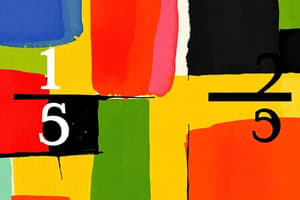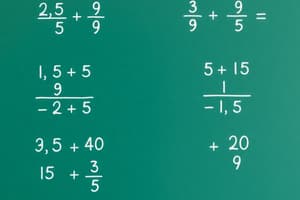Podcast
Questions and Answers
What is the simplest form of the fraction (\frac{12}{24}) ?
What is the simplest form of the fraction (\frac{12}{24}) ?
- \(\frac{3}{4}\)
- \(\frac{1}{3}\)
- \(\frac{1}{2}\) (correct)
- \(\frac{2}{3}\)
Which of the following is an equivalent fraction of (\frac{3}{5}) ?
Which of the following is an equivalent fraction of (\frac{3}{5}) ?
- \(\frac{9}{15}\) (correct)
- \(\frac{12}{18}\)
- \(\frac{6}{7}\)
- \(\frac{15}{20}\)
Which of the following fractions is the largest? (\frac{2}{3}, \frac{3}{4}, \frac{5}{6}, \frac{7}{8}) ?
Which of the following fractions is the largest? (\frac{2}{3}, \frac{3}{4}, \frac{5}{6}, \frac{7}{8}) ?
- \(\frac{2}{3}\)
- \(\frac{5}{6}\)
- \(\frac{7}{8}\) (correct)
- \(\frac{3}{4}\)
What is the result of (\frac{1}{2} \times \frac{2}{3}) ?
What is the result of (\frac{1}{2} \times \frac{2}{3}) ?
Which of the following is a mixed number equivalent to (\frac{17}{5}) ?
Which of the following is a mixed number equivalent to (\frac{17}{5}) ?
What is the result of (\frac{3}{4} + \frac{1}{2}) ?
What is the result of (\frac{3}{4} + \frac{1}{2}) ?
What is the result of (\frac{2}{3} \div \frac{1}{2}) ?
What is the result of (\frac{2}{3} \div \frac{1}{2}) ?
Which of the following scenarios is best represented by the fraction (\frac{3}{5}) ?
Which of the following scenarios is best represented by the fraction (\frac{3}{5}) ?
Flashcards
Fraction
Fraction
A part of a whole expressed as a/b, with 'a' as numerator and 'b' as denominator.
Proper Fraction
Proper Fraction
A fraction where the numerator is smaller than the denominator, e.g., 2/3.
Improper Fraction
Improper Fraction
A fraction where the numerator is greater than or equal to the denominator, e.g., 5/3.
Mixed Number
Mixed Number
Signup and view all the flashcards
Equivalent Fractions
Equivalent Fractions
Signup and view all the flashcards
Comparing Fractions
Comparing Fractions
Signup and view all the flashcards
Adding Fractions
Adding Fractions
Signup and view all the flashcards
Dividing Fractions
Dividing Fractions
Signup and view all the flashcards
Study Notes
Introduction to Fractions
- A fraction represents a part of a whole.
- It's written as a/b, where 'a' is the numerator and 'b' is the denominator.
- The denominator indicates the total number of equal parts the whole is divided into.
- The numerator indicates the number of parts being considered.
- For example, in the fraction 3/4, the whole is divided into 4 equal parts, and 3 of those parts are being considered.
Types of Fractions
- Proper fractions: The numerator is smaller than the denominator (e.g., 2/3).
- Improper fractions: The numerator is greater than or equal to the denominator (e.g., 5/3).
- Mixed numbers: A combination of a whole number and a proper fraction (e.g., 1 2/3).
- Equivalent fractions: Different fractions representing the same part of a whole (e.g.,1/2=2/4).
Equivalent Fractions
- Equivalent fractions can be obtained by multiplying or dividing both the numerator and denominator of a fraction by the same non-zero number.
- Simplifying a fraction involves expressing it in its simplest form by finding the greatest common divisor (GCD) of the numerator and denominator and dividing both by it.
- Simplifying fractions makes them easier to work with.
Comparing Fractions
- To compare fractions with the same denominator, compare the numerators. The fraction with the larger numerator is the greater fraction.
- To compare fractions with different denominators, find equivalent fractions with a common denominator and then compare the numerators.
- Use the concept of cross-multiplication to compare fractions; multiply the numerator of the first fraction by the denominator of the second, and the numerator of the second fraction by the denominator of the first; larger product indicates the larger fraction.
Fraction Operations: Addition and Subtraction
- To add or subtract fractions with the same denominator, add or subtract the numerators and keep the denominator the same.
- To add or subtract fractions with different denominators, find equivalent fractions with a common denominator first.
Fraction Operations: Multiplication
- To multiply fractions, multiply the numerators together and the denominators together.
- Simplify the resulting fraction, if possible.
Fraction Operations: Division
- To divide fractions, invert the second fraction (reciprocal), and then multiply the first fraction by the inverted second fraction.
- Simplify the resulting fraction, if possible.
Converting Between Fractions, Decimals, and Percentages
- Fractions can be converted to decimals by dividing the numerator by the denominator.
- Decimals can be converted to fractions by expressing the decimal as a fraction and simplifying it.
- Fractions can be converted to percentages by converting the fraction to a decimal and then multiplying by 100%.
- Percentages can be converted to fractions or decimals by dividing by 100%.
Studying That Suits You
Use AI to generate personalized quizzes and flashcards to suit your learning preferences.




